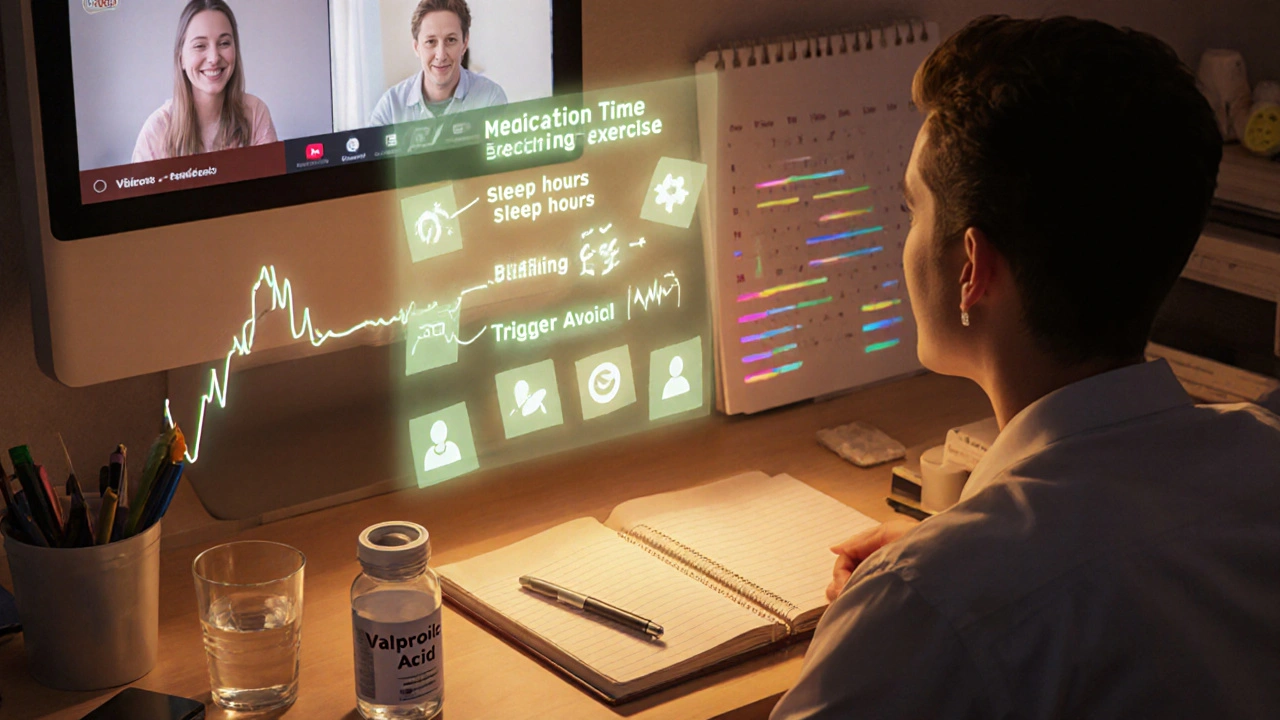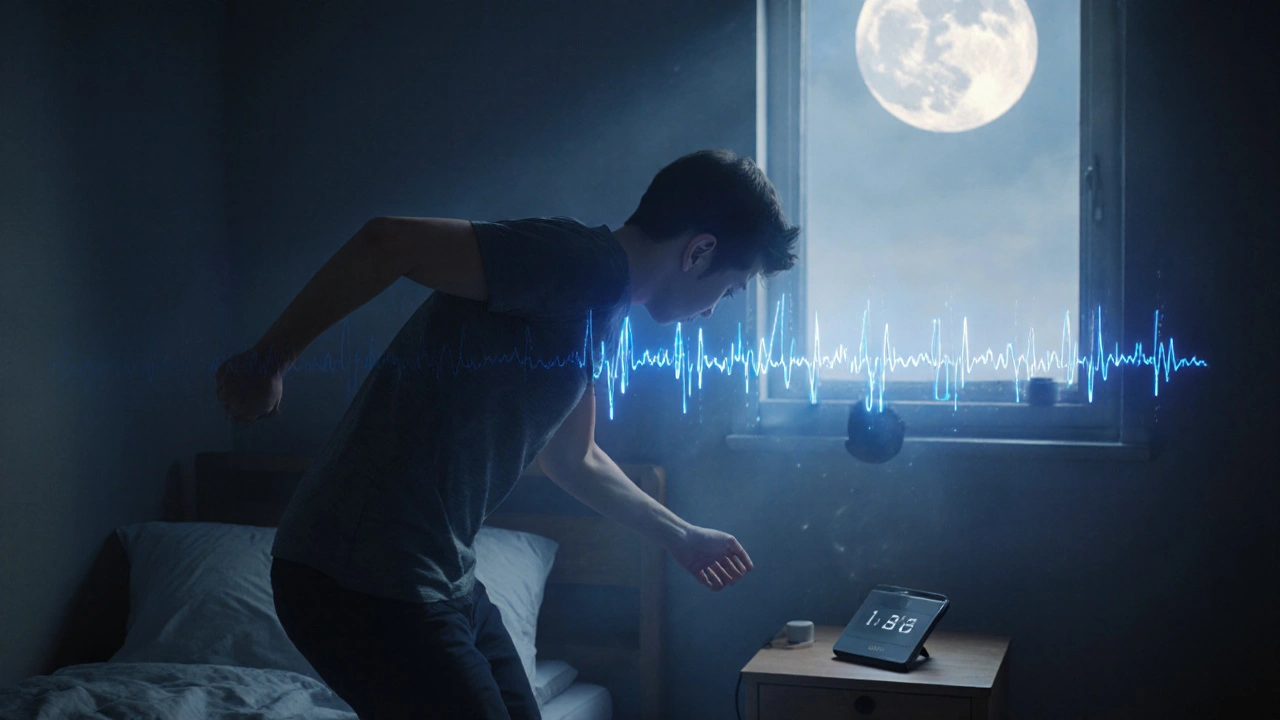Myoclonic Seizure Trigger Identifier
Click on each factor below to indicate if it applies to your situation:
Click "Analyze Potential Triggers" to see personalized insights based on your selections.
Key Takeaways
- Myoclonic seizures are brief, shock‑like jerks that can affect any part of the body.
- Accurate diagnosis often involves an EEG and a careful review of triggers.
- First‑line antiepileptic drugs such as valproic acid, levetiracetam, and clobazam have distinct benefits and side‑effect profiles.
- Resilience isn’t just an attitude - it’s built on medical support, lifestyle tweaks, and a strong community.
- A simple daily checklist can help patients and caregivers stay ahead of seizures.
What Are myoclonic seizures?
In plain language, a myoclonic seizure is a sudden, involuntary muscle twitch that lasts less than a second. Unlike the rhythmic shaking of a tonic‑clonic seizure, the jerk is brief and often feels like a electric shock. These events can involve the arms, legs, face, or the entire body, and they may happen singly or in clusters.
Myoclonic seizures belong to the broader umbrella of epilepsy, a neurological condition where the brain’s electrical activity becomes unstable. The hallmark of a myoclonic episode on an electroencephalogram (EEG) is a rapid, generalized spike‑and‑wave pattern that spikes in less than 100 milliseconds.
Because the jerks are so brief, they’re sometimes missed by observers. Many people first notice a “muscle hiccup” after waking or during a stressful moment. If these jerks happen repeatedly, especially after waking, it’s a red flag for a condition called juvenile myoclonic epilepsy (JME), which accounts for roughly 10‑15% of all epilepsy cases.

Common Triggers & Warning Signs
Understanding what sets off a myoclonic seizure can be a game‑changer. Here are the most frequent culprits:
- Sleep deprivation: Missing just a few hours can lower the seizure threshold dramatically.
- Stress: Emotional spikes trigger a surge of cortisol, which can destabilize neuronal firing.
- Alcohol: Even moderate drinking can interfere with medication levels.
- Bright, flickering lights: Some patients are photosensitive, so strobe lights or video games may provoke jerks.
- Medication non‑adherence: Skipping a dose is often the first trigger in people on antiepileptic drugs.
Early warning signs include a brief “aura” of tingling, a feeling of light‑headedness, or a subtle muscle twitch that precedes the full‑blown jerk. Keeping a seizure diary helps spot patterns that might otherwise be invisible.
Medical Management Options
When seizures become frequent, medication is the frontline defense. The choice of drug depends on age, lifestyle, and side‑effect tolerance. Below is a quick comparison of the three most prescribed agents for myoclonic seizures.
| Drug | Typical Dose (Adult) | Effectiveness | Common Side Effects | Special Considerations |
|---|---|---|---|---|
| Valproic Acid | 500‑1500mg daily, divided | High - works for >80% of JME patients | Weight gain, hair loss, liver enzyme elevation | Contraindicated in pregnancy; requires liver function monitoring |
| Levetiracetam | 500‑3000mg daily, divided | Moderate‑high - especially good for patients who can’t take valproate | Irritability, mood swings, fatigue | Minimal drug interactions; safe in pregnancy |
| Clobazam | 10‑20mg daily | Adjunctive - often added when seizures persist | Sedation, dizziness, tolerance over time | May interact with other benzodiazepines; short‑term use preferred |
Choosing the right drug is a partnership between neurologist and patient. Blood tests, liver panels, and regular EEG checks keep the treatment on track.
Building Personal Resilience
Resilience isn’t a mystical power; it’s a toolbox you fill over time. Here are five evidence‑based strategies that make a real difference:
- Neuroplasticity exercises: Activities like piano, dance, or bilingual learning can rewire brain circuits and raise seizure thresholds.
- Mind‑body practices: Daily 10‑minute mindfulness or yoga sessions lower cortisol and improve sleep quality.
- Consistent sleep hygiene: Go to bed at the same time, limit screens an hour before sleep, and keep the bedroom dark.
- Support groups: Connecting with peers through local chapters of the Epilepsy Foundation or online forums reduces isolation and shares coping hacks.
- Professional counseling: A psychologist trained in chronic illness can teach CBT techniques to manage anxiety that often precedes seizures.
These practices don’t replace medication, but they amplify its effectiveness and improve quality of life.

Real Stories of Strength
Emma, 19, college sophomore - Emma’s first myoclonic seizure happened during a midnight study session. The jerk lasted a split second, but the fear lingered. After a neurologist diagnosed JME, Emma started valproic acid and joined a campus epilepsy club. By integrating 15‑minute breathing drills before exams and setting a strict 8‑hour sleep schedule, her seizure frequency dropped from three times a week to once a month. “I still have bad days,” she says, “but I’ve learned how to ask for help before the panic sets in.”
John, 45, high‑school teacher - John experienced sudden arm jerks while grading papers. A routine EEG confirmed myoclonic activity. He switched to levetiracetam because of a family history of liver issues. John also hired a caregiver to help manage medication refills and to remind him of his nightly stretch routine. The combination of medication, a supportive partner, and a weekly peer‑support Zoom call helped him keep his seizures under control while staying in the classroom.
Both stories illustrate that medical treatment, lifestyle adjustments, and community support together forge a resilient path.
Practical Daily Checklist
- Take medication at the same time every day - set an alarm.
- Record any jerks, triggers, and aura feelings in a seizure diary.
- Check sleep duration and quality - aim for 7‑9hours.
- Pause before stressful events - practice a 5‑minute breathing exercise.
- Avoid alcohol and overly bright screens after 6PM.
- Schedule a monthly check‑in with your neurologist or primary care doctor.
- Reach out to a support group at least once a week - online or in‑person.
Cross‑checking this list each evening can catch early warning signs and keep seizures from spiraling.
Frequently Asked Questions
What’s the difference between myoclonic and tonic‑clonic seizures?
Myoclonic seizures are brief, shock‑like jerks that last less than a second, while tonic‑clonic seizures involve a sustained stiffening (tonic) followed by rhythmic jerking (clonic) and typically last 1‑3 minutes.
Can I drive with myoclonic seizures?
Licensing rules vary by state, but generally you need a seizure‑free period (often 6‑12 months) and a physician’s clearance. Consistent medication adherence and a seizure diary are essential for proving stability.
Are there diet changes that help?
The ketogenic diet has shown benefit for some epilepsy types, but evidence for myoclonic seizures is limited. If you consider it, do so under medical supervision to avoid nutrient deficiencies.
How often should I get an EEG?
After the initial diagnosis, a follow‑up EEG is usually done after 6‑12 months of stable medication to assess any changes in the spike‑and‑wave pattern.
What should I tell friends or coworkers?
Explain that a myoclonic seizure is a brief muscle twitch, not a full collapse. Let them know it’s safe to stay calm, note the time, and avoid restraining the person. Encourage them to ask you about any specific accommodations you need.


Chelsea Hackbarth
October 9, 2025 AT 15:01Myoclonic seizures often sneak in when the brain’s electrical balance is tipped – think of it like a brief hiccup in the neural circuitry. Common culprits include sleep deprivation, stress spikes, and flashing lights, all of which you can track with a simple diary. 🗒️ Adding a consistent bedtime routine and a low‑stimulus environment after sunset can shave down the frequency dramatically. 🍃
Adam Shooter
October 11, 2025 AT 22:35From a neurophysiological perspective, the spike‑and‑wave discharges characteristic of juvenile myoclonic epilepsy represent a failure of thalamocortical inhibitory gating, thereby precipitating the abrupt myoclonic jerks. Empirical meta‑analyses underscore the primacy of valproate’s broad‑spectrum efficacy, albeit with hepatotoxicity risk, whereas levetiracetam’s mechanistic modulation of SV2A affirms its utility in comorbid anxiety phenotypes. Consequently, a stratified therapeutic algorithm that integrates pharmacogenomic profiles may optimize seizure control while mitigating iatrogenic sequelae.
Ria Ayu
October 14, 2025 AT 06:08It’s striking how the mind can both trigger and tame these fleeting jolts, isn’t it? When you sit with the experience, you often discover a subtle pattern-a lingering stressor or a missed night of sleep-that serves as the prelude. Embracing a compassionate curiosity, rather than frustration, can transform the seizure diary into a map of personal resilience. In this way, each recorded episode becomes a lesson in self‑awareness rather than a mere symptom.
maya steele
October 16, 2025 AT 13:41Thank you for sharing such a comprehensive overview of myoclonic seizures; the depth of information serves both newly diagnosed individuals and seasoned caregivers alike. First, it is essential to recognize that the episodic nature of these jerks does not diminish their impact on daily functioning, and therefore a structured management plan is warranted. Second, consistent adherence to antiepileptic medication, as outlined in the comparative table, remains the cornerstone of seizure mitigation. Third, integrating lifestyle modifications-such as optimal sleep hygiene, stress reduction techniques, and avoidance of known photic triggers-can synergistically lower the seizure threshold. Fourth, maintaining a detailed seizure diary enables patients to identify subtle precipitating factors that might otherwise go unnoticed. Fifth, regular follow‑up appointments with a neurologist ensure therapeutic levels are monitored and side‑effects are addressed promptly. Sixth, engaging with support groups provides psychosocial reinforcement, which has been shown to improve overall quality of life. Seventh, neuroplasticity‑enhancing activities like music or language learning can foster cortical stability over time. Eighth, mindfulness and yoga practices have demonstrated efficacy in reducing cortisol spikes that often precede episodes. Ninth, caregivers should be educated on emergency protocols, including when to seek urgent medical attention. Tenth, families benefit from open communication, allowing for shared responsibility in medication management. Eleventh, for those considering dietary interventions, professional guidance is imperative to avoid nutritional deficiencies. Twelfth, patients should be aware of legal considerations regarding driving, with clear guidelines varying by jurisdiction. Thirteenth, the role of technology, such as wearable seizure detectors, is an emerging adjunct that can provide real‑time alerts. Finally, cultivating resilience is a multifaceted endeavor that blends medical, behavioral, and community resources into a cohesive strategy for thriving despite the challenges posed by myoclonic seizures.
Sharon Lax
October 18, 2025 AT 07:21While the checklist is thorough, it perhaps underplays the burden of polypharmacy on patients who already grapple with medication fatigue. A more critical appraisal of the trade‑offs between efficacy and side‑effects would enhance the practical utility of the guide.
paulette pyla
October 20, 2025 AT 01:01Oh, absolutely-because nothing says “real resilience” like demanding patients juggle an endless cocktail of drugs while we all cheer from the sidelines. 🙄 If only the healthcare system cared enough to simplify the regimen, we wouldn’t need these endless checklists.
Benjamin Cook
October 22, 2025 AT 08:35Wow!!! This is sooo helpful!!! I'm gonna start a 5‑min breathing drill before every class and set 8‑hour alarms for sleep!!! Gotta keep those jerks away!!! Lemme know if it works!!!
karthik rao
October 24, 2025 AT 02:15It’s commendable that you’re adopting proactive measures; however, a minor orthographic correction: “8‑hour” should be hyphenated without spaces to maintain typographic consistency. Additionally, consider documenting the exact time of each breathing exercise to facilitate quantitative analysis of its efficacy 📊. 😊
Breanne McNitt
October 26, 2025 AT 09:48Hey everyone, love how we’re all pitching in with tips-makes the community feel like a real support squad! I’ve found that sharing a weekly “success story” in the thread helps keep motivation high and reminds us that progress, no matter how small, is worth celebrating.
Ashika Amirta varsha Balasubramanian
October 28, 2025 AT 03:28That’s a wonderful idea; by foregrounding personal narratives we also honor the diverse cultural contexts that shape each individual’s experience with epilepsy. Encouraging members to include traditional coping practices alongside medical advice can enrich the collective knowledge base.
Jacqueline von Zwehl
October 30, 2025 AT 11:01Just a quick note: “myoclonic” is correctly capitalized only when beginning a sentence; otherwise it should remain lowercase. Also, “EEG” should be presented in all caps as it’s an acronym. Small edits, but they keep the post polished.
Christopher Ellis
November 1, 2025 AT 04:41Great info, thanks!